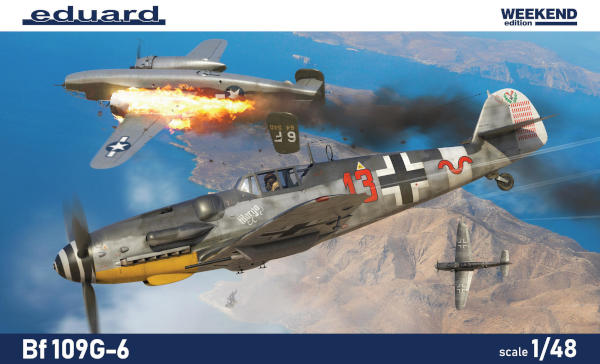
Eduard 1/48 Bf109G-6 Weekend
By Jacob Russell
The Messerschmitt Bf109G-6 was a non-pressurized fighter produced in parallel with the pressurized G-5 variant. The G-6 was more numerous than the G-5 and more widely used and longer-lived. It was introduced into first-line Luftwaffe service in 1943 and was still serving in 1945! Powered by the 1,475 hp Daimler-Benz DB 605A 12 cylinder, the G-6 had a maximum speed of 386 mph at 22,640 feet with MW (Methanol-Wasser) 50 boost and a maximum range of 620 miles with the 300 liter drop tank.
Eduard's new Weekend edition kit comes in their customary stout box with cool artwork of a pair of Bf109G-6 fighters dispatching a B-25 Mitchell high over the Mediterranean. It consists of 184 plastic parts on 5 sprues, one of which is clear.
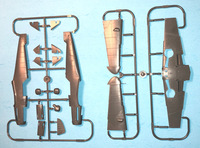
|
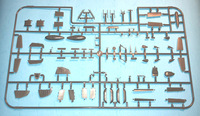
|
The surface detail on the wings and fuselage consists of recessed panel lines and rivets and this detail is superb. The wheel wells are deep, multi-piece moldings that are convincing. The leading edge slats are separate pieces. The ailerons, under wing radiator flaps and horizontal stabilizers are also individual pieces. The fabric effect on the ailerons, rudder and horizontal stabilizers is good. The landing gear are well executed.
Optional parts include a number of Rustsatze (field conversion sets): R-1 (ETC 900/IXb rack with SC 250 bomb), R-2 (ETC 50/VIId rack with 4 SC 50 bombs), R-3 (300 liter drop tank), R-6 (MG 151/20MM under wing cannon) and R-7 (Direction Finding (DF) loop). The clear parts include 2 gun sights, 3 different windscreens, the fuel line, "Galland Panzer" canopy armor and 3 different Erla Haube canopies.
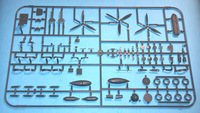
|

|
Eduard's decals are crisply printed, with bright colors and good registration. There are 2 sheets, one of which is 2 sets of air frame stencils. The main decal sheet is kind of a "Greatest Hits" selection of familiar G-6s. There are 4 different aircraft options, all of which sport the under wing "Gondola" cannon:
"Red 13", G-6/Trop, W.Nr. 27169, Fw. Heinrich Bartels, 11./JG 27, Kalamaki Airfield, Greece, November 1943. The camouflage is the standard mid War colors of RLM 74 and 75 over 76 with a moderate mottle of 74 and 75, a black spinner with a white spiral, RLM 70/white spinner backing plate, RLM 04 Yellow lower cowl and white fuselage band and rudder. This plane is also notable for the "sawtooth" upper camouflage pattern normally associated with the G-8 reconnaisance variant.
"White 10", G-6, Oblt. Alfred Grislawski, CO of 1../JGr. 50, Wiesbaden-Erbenheim Air Base, Germany, September 1943. The camouflage was RLM 74/75/76 with a moderate mottle of 74 and 75, RLM 70/white spinner and backing plate, RLM 04 Yellow lower cowl and white fin, rudder and lower rear fuselage. The lower surface RLM 76 wraps over the wing leading with a wavy demarcation line and the starboard aileron was solid RLM 75.
"Black Chevron", Maj. Ludwig Franzisket, CO of 1./NJGr. 10, Werneuchen, Germany, July 1944. The camouflage was RLM 74/75/76 with a wide RLM 25 Green fuselage band, RLM 04 Yellow lower cowl and white rudder. The camouflage demarcation was both wavy and carried low down on the fuselage sides with a loose 74/75 mottle. The fuselage crosses had an RLM 75 "fill" and the spinner was RLM 70.
"Black Chevron", G-6/Trop, Maj. Kurt Ubben, CO of III./JG 77, Foggia, Italy, May 1943. The camouflage was RLM 74/75/76 with an RLM 04 yellow lower cowl and white spinner and fuselage band. The fuselage mottling was sparse and mostly RLM 75. The lower surface RLM 76 wraps over the wing leading with a wavy demarcation line.
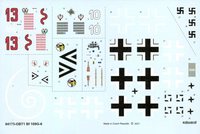
|
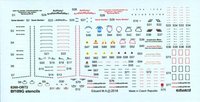
|
The instructions are up to Eduard's usual standards. The instructions include a parts map, a well illustrated and logical build sequence, full color profiles of all 4 decal options and a stencil application guide. Color call outs are for GSI Creos (Gunze) Aqueous, Mr. Color and Mission Models paints.
The Bf109G-6 Weekend has 4 exciting decal options and you have your pick of the various Brassin and PE sets if you want to add some detail. I recommend this kit and I would like to thank Eduard for the review sample.
References
Messerschmitt Bf109 in action Part 2, Aircraft Number 57, by John R. Beaman, Jr., Squadron/Signal Publications, 1983
